Denon DRA-297 User Manual

AM-FM STEREO RECEIVER
DRA-297
OPERATING INSTRUCTIONS
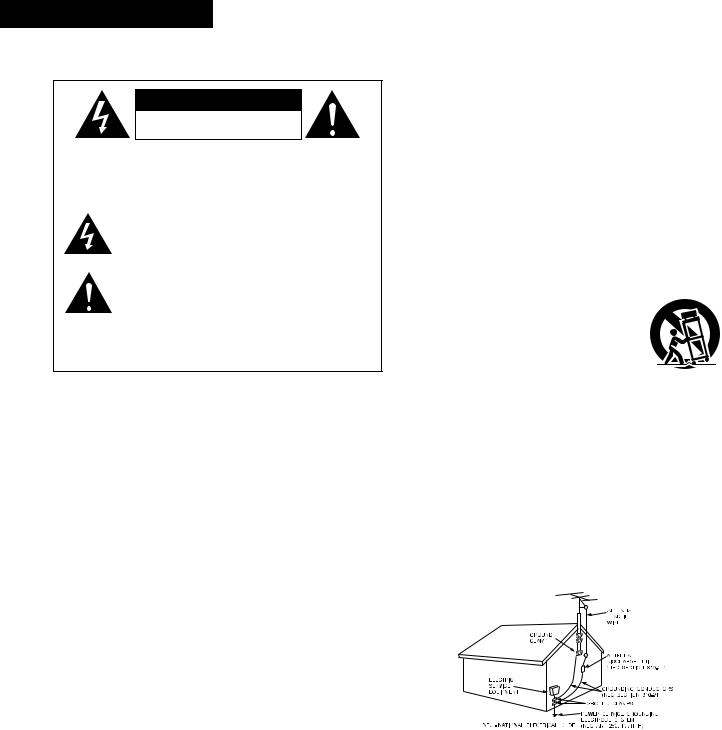
ENGLISH
¢SAFETY PRECAUTIONS
CAUTION
RISK OF ELECTRIC SHOCK
DO NOT OPEN
CAUTION:
TO REDUCE THE RISK OF ELECTRIC SHOCK, DO NOT REMOVE COVER (OR BACK). NO USER-SERVICEABLE PARTS INSIDE. REFER SERVICING TO QUALIFIED SERVICE PERSONNEL.
The lightning flash with arrowhead symbol, within an equilateral triangle, is intended to alert the user to the presence of uninsulated “dangerous voltage” within the product’s enclosure that may be of sufficient magnitude to constitute a risk of electric shock to persons.
The exclamation point within an equilateral triangle is intended to alert the user to the presence of important operating and maintenance (servicing) instructions in the literature accompanying the appliance.
WARNING:
TO REDUCE THE RISK OF FIRE OR ELECTRIC SHOCK, DO NOT EXPOSE THIS APPLIANCE TO RAIN OR MOISTURE.
SAFETY INSTRUCTIONS
1.Read Instructions – All the safety and operating instructions should be read before the product is operated.
2.Retain Instructions – The safety and operating instructions should be retained for future reference.
3.Heed Warnings – All warnings on the product and in the operating instructions should be adhered to.
4.Follow Instructions – All operating and use instructions should be followed.
5.Cleaning – Unplug this product from the wall outlet before cleaning. Do not use liquid cleaners or aerosol cleaners.
6.Attachments – Do not use attachments not recommended by the product manufacturer as they may cause hazards.
7.Water and Moisture – Do not use this product near water – for example, near a bath tub, wash bowl, kitchen sink, or laundry tub; in a wet basement; or near a swimming pool; and the like.
8.Accessories – Do not place this product on an unstable cart, stand, tripod, bracket, or table. The product may fall, causing serious injury to a child or adult, and serious damage to the product. Use only with a cart, stand, tripod, bracket, or table recommended by the manufacturer, or sold with the product. Any mounting of the product should
follow the manufacturer’s instructions, and should use a mounting accessory recommended by the manufacturer.
9. A product and cart combination should be moved with care. Quick stops, excessive force, and uneven surfaces may cause the product and cart combination to overturn.
10.Ventilation – Slots and openings in the cabinet are provided for ventilation and to ensure reliable operation of the product and to protect it from overheating, and these openings must not be blocked or covered. The openings should never be blocked by placing the product on a bed, sofa, rug, or other similar surface. This product should not be placed in a built-in installation such as a bookcase or rack unless proper ventilation is provided or the manufacturer’s instructions have been adhered to.
11.Power Sources – This product should be operated only from the type of power source indicated on the marking label. If you are not sure of the type of power supply to your home, consult your product dealer or local power company. For products intended to operate from battery power, or other sources, refer to the operating instructions.
12.Grounding or Polarization – This product may be equipped with a polarized alternating-current line plug (a plug having one blade wider than the other). This plug will fit into the power outlet only one way. This is a safety feature. If you are unable to insert the plug fully into the outlet, try reversing the plug. If the plug should still fail to fit, contact your electrician to replace your obsolete outlet. Do not defeat the safety purpose of the polarized plug.
FIGURE A
EXAMPLE OF ANTENNA GROUNDING
AS PER NATIONAL
ELECTRICAL CODE
13.Power-Cord Protection – Power-supply cords should be routed so that they are not likely to be walked on or pinched by items placed upon or against them, paying particular attention to cords at plugs, convenience receptacles, and the point where they exit from the product.
15.Outdoor Antenna Grounding – If an outside antenna or cable system is connected to the product, be sure the antenna or cable system is grounded so as to provide some protection against voltage surges and built-up static charges. Article 810 of the National Electrical Code, ANSI/NFPA 70, provides information with regard to proper grounding of the mast and supporting structure, grounding of the lead-in wire to an antenna discharge unit, size of grounding conductors, location of antenna-discharge unit, connection to grounding electrodes, and requirements for the grounding electrode. See Figure A.
16.Lightning – For added protection for this product during a lightning storm, or when it is left unattended and unused for long periods of time, unplug it from the wall outlet and disconnect the antenna or cable system. This will prevent damage to the product due to lightning and power-line surges.
17.Power Lines – An outside antenna system should not be located in the vicinity of overhead power lines or other electric light or power circuits, or where it can fall into such power lines or circuits. When installing an outside antenna system, extreme care should be taken to keep from touching such power lines or circuits as contact with them might be fatal.
18.Overloading – Do not overload wall outlets, extension cords, or integral convenience receptacles as this can result in a risk of fire or electric shock.
19.Object and Liquid Entry – Never push objects of any kind into this product through openings as they may touch dangerous voltage points or short-out parts that could result in a fire or electric shock. Never spill liquid of any kind on the product.
20.Servicing – Do not attempt to service this product yourself as opening or removing covers may expose you to dangerous voltage or other hazards. Refer all servicing to qualified service personnel.
21.Damage Requiring Service – Unplug this product from the wall outlet and refer servicing to qualified service personnel under the following conditions:
a)When the power-supply cord or plug is damaged,
b)If liquid has been spilled, or objects have fallen into the product,
c)If the product has been exposed to rain or water,
d)If the product does not operate normally by following the operating instructions. Adjust only those controls that are covered by the operating instructions as an improper adjustment of other controls may result in damage and will often require extensive work by a qualified technician to restore the product to its normal operation,
e)If the product has been dropped or damaged in any way, and
f)When the product exhibits a distinct change in performance – this indicates a need for service.
22.Replacement Parts – When replacement parts are required, be sure the service technician has used replacement parts specified by the manufacturer or have the same characteristics as the original part. Unauthorized substitutions may result in fire, electric shock, or other hazards.
23.Safety Check – Upon completion of any service or repairs to this product, ask the service technician to perform safety checks to determine that the product is in proper operating condition.
24.Wall or Ceiling Mounting – The product should be mounted to a wall or ceiling only as recommended by the manufacturer.
25.Heat – The product should be situated away from heat sources such as radiators, heat registers, stoves, or other products (including amplifiers) that produce heat.
I
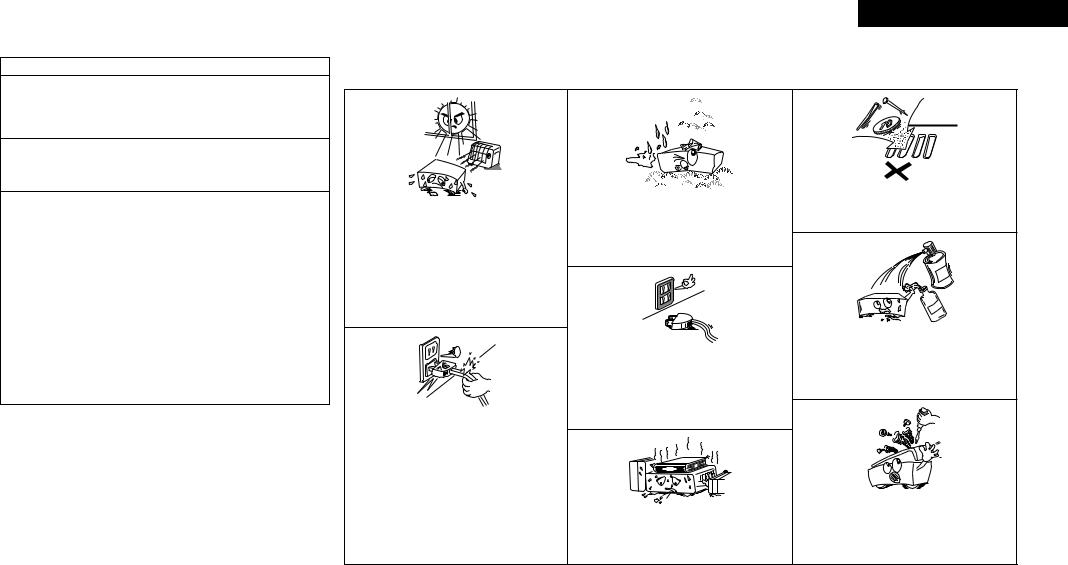
FCC INFORMATION (For US customers)
1. PRODUCT
This product complies with Part 15 of the FCC Rules. Operation is subject to the following two conditions: (1) this product may not cause harmful interference, and (2) this product must accept any interference received, including interference that may cause undesired operation.
2.IMPORTANT NOTICE: DO NOT MODIFY THIS PRODUCT
This product, when installed as indicated in the instructions contained in this manual, meets FCC requirements. Modification not expressly approved by DENON may void your authority, granted by the FCC, to use the product.
3.NOTE
This product has been tested and found to comply with the limits for a Class B digital device, pursuant to Part 15 of the FCC Rules. These limits are designed to provide reasonable protection against harmful interference in a residential installation.
This product generates, uses and can radiate radio frequency energy and, if not installed and used in accordance with the instructions, may cause harmful interference to radio communications. However, there is no guarantee that interference will not occur in a particular installation. If this product does cause harmful interference to radio or television reception, which can be determined by turning the product OFF and ON, the user is encouraged to try to correct the interference by one or more of the following measures:
•Reorient or relocate the receiving antenna.
•Increase the separation between the equipment and receiver.
•Connect the product into an outlet on a circuit different from that to which the receiver is connected.
•Consult the local retailer authorized to distribute this type of product or an experienced radio/TV technician for help.
ENGLISH
¢NOTE ON USE
•Avoid high temperatures.
Allow for sufficient heat dispersion when installed in a rack.
•Handle the power cord carefully.
Hold the plug when unplugging the cord.
•Keep the apparatus free from moisture, water, and dust.
•Unplug the power cord when not using the apparatus for long periods of time.
*(For apparatuses with ventilation holes)
•Do not obstruct the ventilation holes.
• Do not let foreign objects into the apparatus.
•Do not let insecticides, benzene, and thinner come in contact with the apparatus.
•Never disassemble or modify the apparatus in any way.
II

ENGLISH
Thank you for choosing the DENON DRA-297 AM-FM Stereo Receiver. This remarkable component has been engineered to provide outstanding high fidelity reproduction of your favorite music sources. As this product is provided with an immense array of features, we recommend that before you begin hookup and operation that you review the contents of this manual before proceeding.
Contents
Getting Started
Accessories······················································································2
Before using ····················································································2
Cautions on installation ·································································2
About the remote control unit ······················································3
Inserting the batteries····································································3
Operating range of the remote control unit ································3
Part names and functions
Front panel ·····················································································4
Display····························································································4 Rear panel ······················································································5
Remote control unit ···································································5, 6
Connections
Cable indications ············································································6
Speaker connections ······································································7
Connecting a DVD player and monitor ········································8
Connecting a TV/DBS tuner ··························································8
Connecting a CD player ·································································8
Connecting a tape deck, CD recorder or MD recorder················8
Connecting a VCR···········································································9
Connecting the antenna terminals ···············································9
Connecting the XM terminal ·······················································10
Connecting the iPod® ··································································10
Connecting a room-to-room remote control unit ·····················11
Connecting the PRE OUT terminals············································11
Connecting the power supply cord ············································11
Operation
Before operating ···········································································12
Playing the input source ······························································12
Turning the sound off temporarily (MUTING)·······························12 Listening over headphones ··························································12
Switching the speakers································································12 Checking the currently playing program source, etc. ··················13
Switching the brightness of the display·······································13 Selecting the play mode (PURE DIRECT) ····································13
Setting the tone control ·······························································13
Adjusting the speaker volume ·····················································13
Combining the currently playing sound
with the desired image (VIDEO SELECT function)····················13
Listening to the radio···································································14
Auto preset memory ····································································14
Auto tuning···················································································14 Manual tuning ··············································································14
Preset memory ············································································14
Recalling preset stations ······························································14
XM Satellite Radio········································································15
Checking the XM signal strength and Radio ID ···························15
Channel selection·········································································16 Category search ···········································································16
Direct access of channels ····························································16
Playing the iPod® ·········································································16
Setting the iPod Assignment ·······················································16
Listening to music········································································17 Listening to music in the Browse mode······································17 Viewing still pictures and videos (only for iPods
equipped with the slideshow / video function) ····························18
Disconnecting the iPod ································································18
Recording the program source
(recording the source currently being monitored)····················18
About the memory functions ······················································18
Initialization of the microprocessor············································18
Operating the remote control unit
Operating DENON audio components ·······································19
Setting the preset memory function ··········································19
Operating a component stored in the preset memory ····20 ~ 22
Setting the punch through function···········································23
Troubleshooting ············································································24
Specifications ················································································25
1
ENGLISH
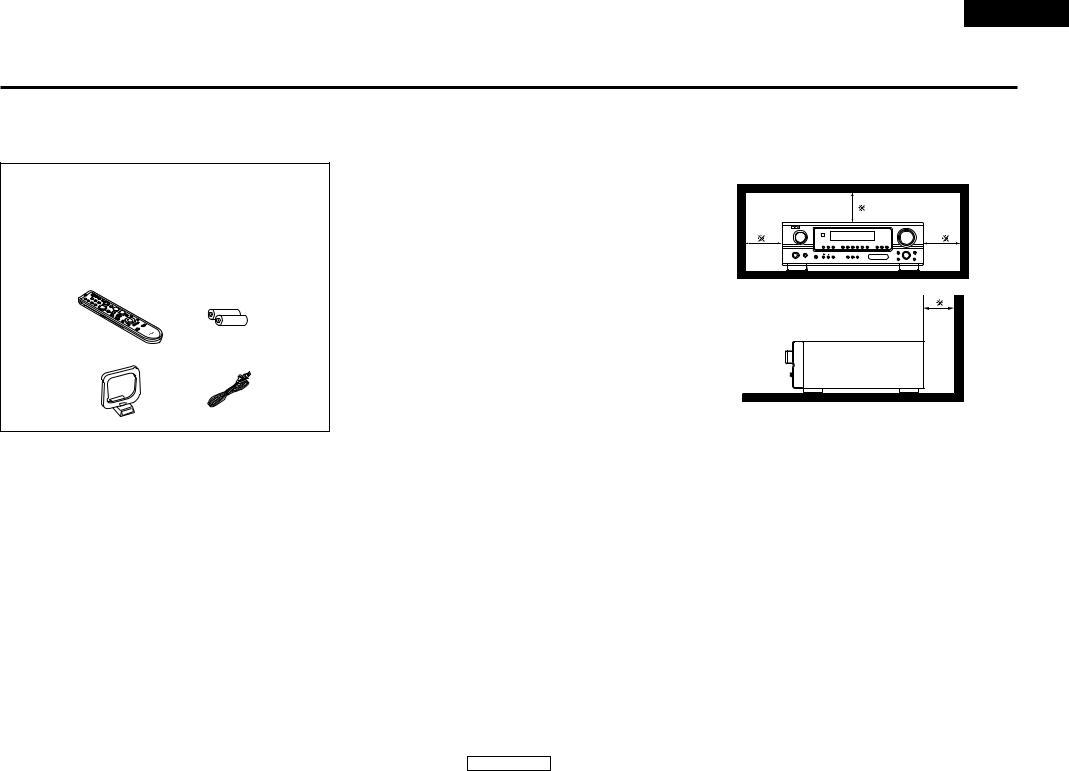
ENGLISH
Getting Started
Accessories |
|
Before using |
|
Cautions on installation |
Check that the following parts are attached in addition to the main unit:
q Operating instructions .............................................................. |
1 |
w Warranty (for North America model only)..................................... |
1 |
e Service station list .................................................................... |
1 |
r Remote control unit (RC-1053)................................................. |
1 |
t R6P/AA batteries ...................................................................... |
2 |
y AM loop antenna ...................................................................... |
1 |
u FM indoor antenna ................................................................... |
1 |
r |
t |
y |
u |
Pay attention to the following before using this unit: |
Note: |
|
• Moving the unit. |
For heat dispersal, do not install this unit in a confined space |
|
such as a bookcase or similar enclosure. |
||
To prevent short-circuits or damaged wires in the connection cables, |
||
|
||
always unplug the power supply cord and disconnect the connection |
|
|
cables between all other audio components when moving the unit. |
|
|
• Cautions on using mobile phones. |
Note |
|
Using a mobile phone near this unit may result in noise. If so, move |
|
|
the mobile phone away from this unit when it is in use. |
|
|
• Before turning the power operation button on. |
|
|
Check once again that all connections are correct and that there are |
|
|
not problems with the connection cables. Always set the power |
|
|
operation button to the standby position before connecting and |
|
|
disconnecting connection cables. |
|
|
• Store the operating instructions in a safe place. |
|
|
After reading the operating instructions, store them in a safe place |
Wall |
|
as they could come in handy in the future. |
||
|
||
• Whenever the power operation button is in the STANDBY state, |
|
|
the unit is still connected to AC line voltage. |
|
|
Please be sure to turn off the power operation button or unplug |
|
|
the cord when you leave home for, say, a vacation. |
|
•Note that the illustrations in these instructions may differ from the actual unit for explanation purposes.
2
ENGLISH
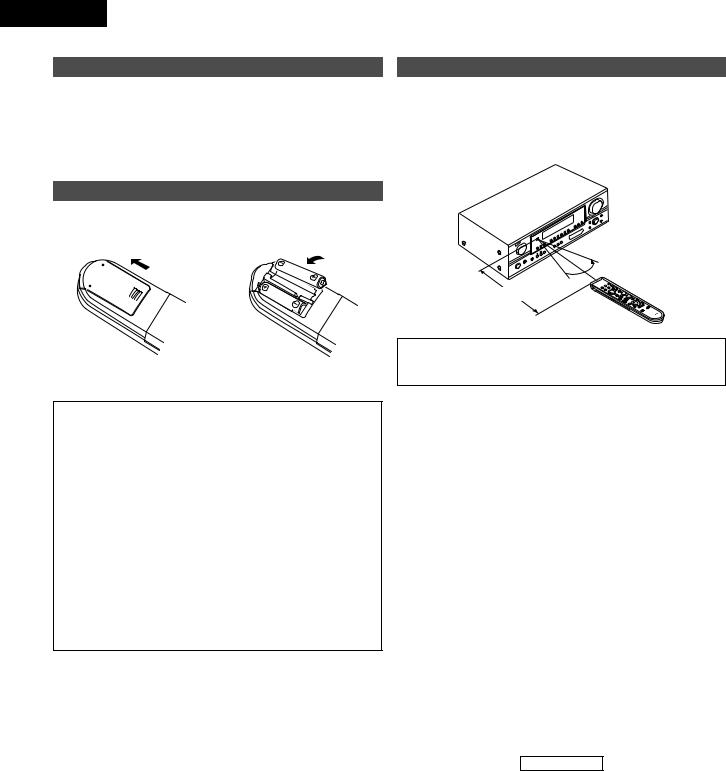
ENGLISH
Getting Started
About the remote control unit
In addition to controlling the DRA-297, the attached remote control unit (RC-1053) can also be used to control the following products: q DENON component products
wComponent products other than DENON:
• Set using the preset memory function (  page 23).
page 23).
Operating range of the remote control unit
•Point the remote control unit at the remote sensor when operating it.
•The remote control unit can be used from a distance of approximately 23 feet/7 meters, at a horizontal angle of up to 30° with respect to the sensor.
Inserting the batteries
q Remove the remote control |
w Set two R6P/AA batteries in |
unit’s rear cover. |
the battery compartment in |
|
the indicated direction. |

 30° 30°
30° 30° 




Approx. 23 feet/7 m
e Put the rear cover back on.
Notes on batteries:
•Replace the batteries with new ones if the set does not operate even when the remote control unit is operated nearby the unit. (The attached batteries are only for verifying operation.)
•When inserting the batteries, be sure to do so in the proper direction, following the “<” and “>” marks in the battery compartment.
•To prevent damage or leakage of battery fluid:
•Do not use a new battery together with an old one.
•Do not use two different types of batteries.
•Do not short-circuit, disassemble, heat or dispose of batteries in flames.
•Remove the batteries from the remote if it will not be in use for long periods.
•If the battery fluid should leak, carefully wipe the fluid off the inside of the battery compartment and insert new batteries.
•When replacing the batteries, have the new batteries ready and insert them as quickly as possible.
NOTE:
•It may be difficult to operate the remote control unit if the remote sensor is exposed to direct sunlight or strong artificial light.
3
Getting Started
ENGLISH

ENGLISH
Getting Started |
Getting Started |
Part names and functions
For details on the functions of these parts, refer to the pages given in parentheses ( ).
Front panel
Display
y t r |
e |
@8 |
@7@6@5 |
@4@3@2 |
@1@0!9 |
!8 |
|
|
|
t |
|
|
|
q w e |
r |
y u |
io!0!1 !2 |
!3!4!5!6!7 |
|
q Power operation button
(ON/STANDBY) ··········································(12)
w Power indicator ·········································(12)
e Power switch ·······································(12, 18) r Headphones jack (PHONES) ·····················(12)
t MODE button ·······································(14, 18) y SPEAKER buttons ······································(12)
u PURE DIRECT button·································(13)
i SHIFT button ··············································(14)
o XM RADIO button······································(16)
!0TONE DEFEAT button ·······························(13)
!1LOUDNESS button ····································(13)
!2STATUS button ··········································(13)
!3MENU button·······································(16, 17)
!4TONE CONTROL button····························(13)
!5SELECT knob········································(13, 17)
!6CH VOL button···········································(13)
!7ENTER button ······································(17, 18)
!8VOLUME control knob ······························(12)
!9MUTING button ·········································(12)
@0DIMMER button ·········································(13)
@1VIDEO SELECT button ······························(13)
@2TUNING buttons (•, ª) ·····························(14)
@3Display
@4PRESET buttons·········································(14)
@5MEMORY button········································(14)
@6Remote control sensor································(3)
@7BAND button··············································(14)
@8INPUT SELECTOR knob ····························(12)
|
|
w |
q |
||
q Signal channel indicator
Lights when the preset channel is displayed at w.
w Information display
e Volume indicator
This displays the volume level.
r STEREO indicator
This lights when an FM stereo broadcast has been received.
t AUTO indicator
This lights when the broadcast station is selected in the AUTO tuning mode.
y TUNED indicator
This lights when an FM/AM broadcast has been received.
4
ENGLISH
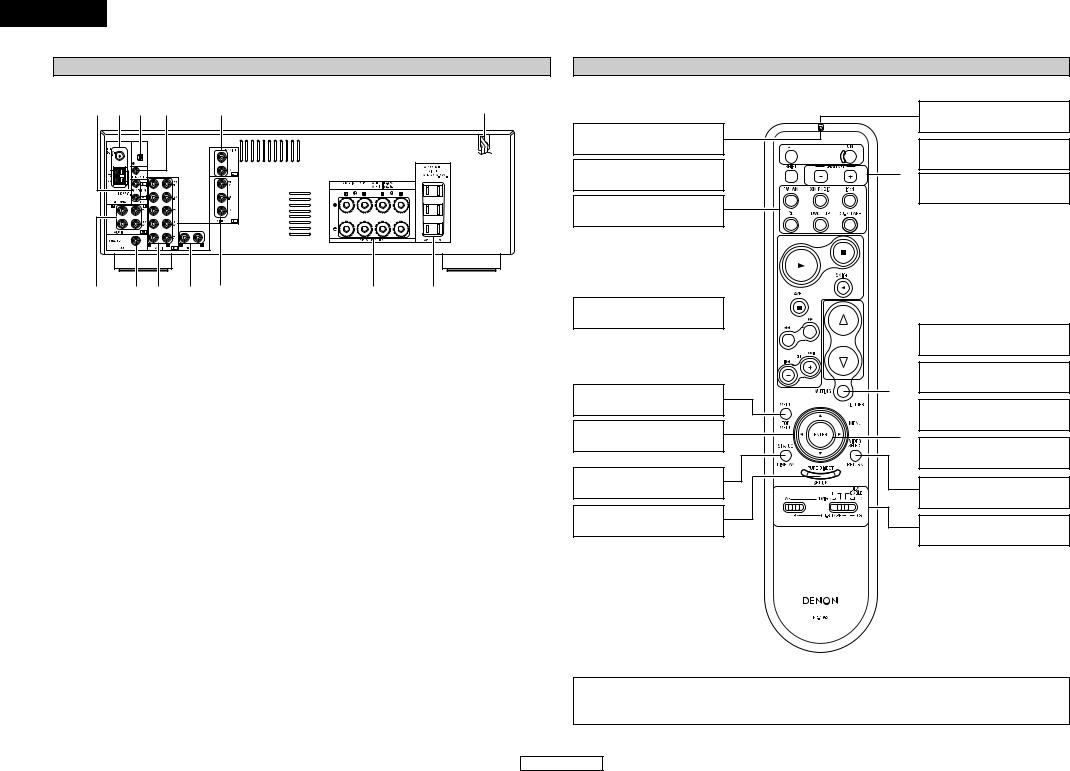
ENGLISH
Getting Started
Rear panel
!3!2!1!0 |
o |
|
i |
q w e r t |
y |
u |
|
q AUDIO OUT terminals·································(8)
w SUBWOOFER PRE OUT terminal ·············(11)
e AUDIO IN terminals·····································(8)
r PRE OUT terminals····································(11)
t VIDEO IN terminals ·····································(8)
y Speaker terminals ·······································(7)
u AC outlets···················································(11)
i Power supply cord·····································(11)
o VIDEO OUT terminals ·································(8)
!0DOCK CONTROL jack ································(10)
!1XM terminal ···············································(10)
!2ANTENNA terminals ···································(9)
!3REMOTE CONTROL jacks ·························(11)
5
Getting Started
Remote control unit
Indicator ··························(19)
SHIFT buttons·················(14) 
Input source selector buttons ····························(12)
System buttons········(20, 23) 
MENU button ···········(16, 17)
Cursor buttons
(D, H, F, G)············(16 ~ 18)
STATUS button ··············(13)
PURE DIRECT/SET UP button······························(13)
[ Front ]
Remote control signal transmitter ························(3)

 Power buttons················(12)
Power buttons················(12)
 CHANNEL buttons ·········(14)
CHANNEL buttons ·········(14)
Volume control
 buttons ····························(12)
buttons ····························(12)
 MUTING button··············(12)
MUTING button··············(12)

 DIMMER button··············(13)
DIMMER button··············(13)
 ENTER button···········(17, 18)
ENTER button···········(17, 18)
VIDEO SELECT
button······························(13)
Mode selector
switches ····················(12, 19)
NOTE:
•If buttons on the front or rear are pressed strongly, the button on the opposite side will be activated too.
ENGLISH
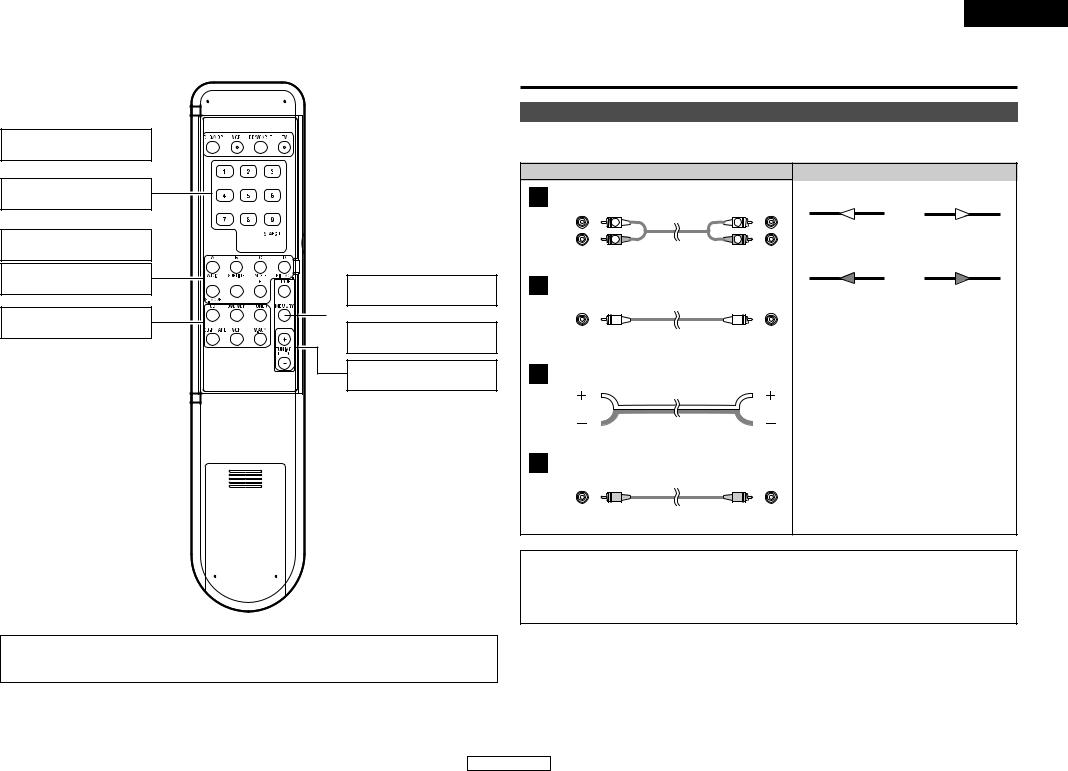
Getting Started
[ Rear ]
Power buttons················(20) 
Number buttons
(0 ~ 9, +10) ················(14, 20)
BAND button ··················(14) 


Memory block
buttons (A ~ G)···············(14)
Input source selector buttons ····························(12)
 MODE button············(14, 18)
MODE button············(14, 18)
 MEMORY button ············(14)
MEMORY button ············(14)
TUNING buttons ············(14)
NOTE:
•If buttons on the front or rear are pressed strongly, the button on the opposite side will be activated too.
ENGLISH
Connections
Cable indications
The hookup diagrams on the subsequent pages assume the use of the following optional connection cables (not supplied).
|
|
Audio cable |
|
Signal direction |
|
|
A |
Analog connections (Stereo) |
|
Audio signal |
|
||
|
|
|
|
|||
(White) |
L |
L |
|
|
|
|
|
|
R |
IN |
OUT |
OUT |
IN |
(Red) |
R |
|
|
|
||
|
|
Video signal |
|
|||
|
|
Pin-plug cable |
|
|
||
B |
Analog connections (Monaural, for subwoofer) |
|
|
|
||
|
|
|
IN |
OUT |
OUT |
IN |
Pin-plug cable
C Speaker connections
Speaker cable
D Video connections
(Yellow)
Video cable (75 Ω/ohms video pin-plug cable)
NOTE:
•Do not plug in the power supply cord until all connections have been completed.
•When making connections, also refer to the operating instructions of the other components.
•Be sure to connect the left and right channels properly (left with left, right with right).
•Do not bundle power cords together with speaker cables. Doing so could result in humming or noise.
6
ENGLISH
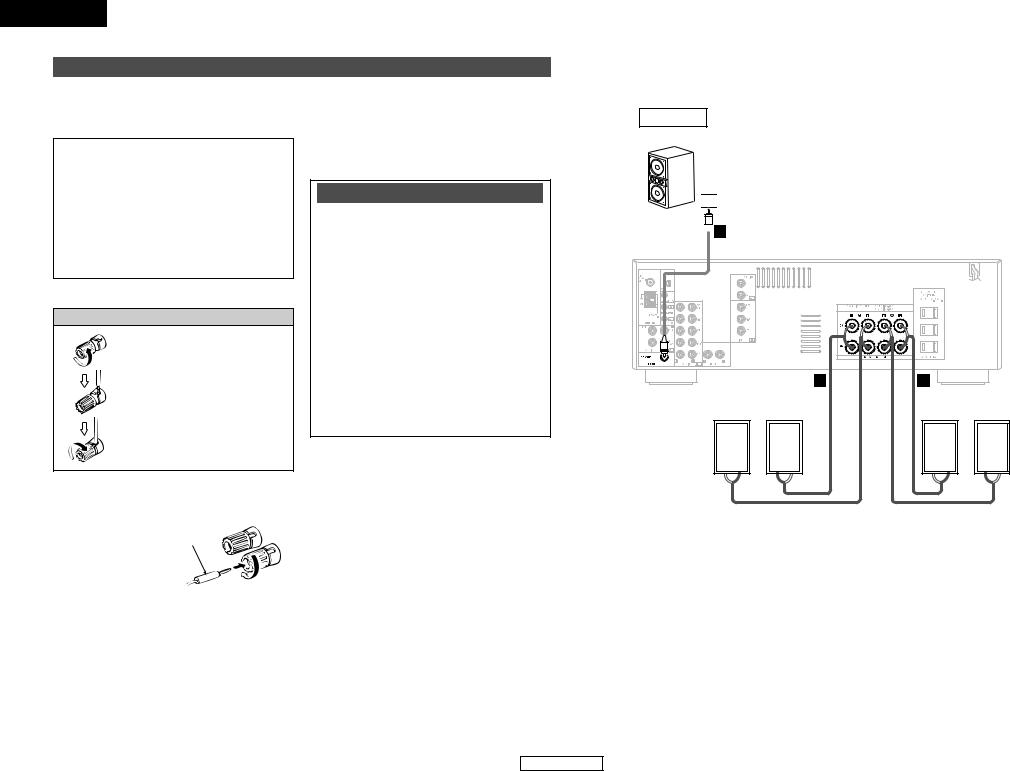
ENGLISH
Connections
Speaker connections
Connect the speaker terminals with the speakers making sure that like polarities are matched (< with <, > with >).
NOTE:
When making connections, take care that none of the individual conductors of the speaker cable come in contact with adjacent terminals, with other speaker cable conductors, or with the rear panel and screws.
NEVER touch the speaker terminals when the power is on. Doing so could result in electric shocks.
Connecting the speaker cables
1. Loosen by turning counterclockwise.
Either tightly twist or terminate the core wires.
2. Insert the cable.
3. Tighten by turning clockwise.
¢ Speaker impedance
Speaker |
Impedance |
A, B |
4 ~ 16 Ω/ohms |
|
|
A+B |
8 ~ 16 Ω/ohms |
|
|
Note on speaker impedance
When using speakers with an impedance below the designated value (for example 4 Ω/ohms), playing for long periods of time with the volume high could cause the temperature to rise, activating the protection circuit.
When the protection circuit is activated, the output to the speakers is cut off and the power indicator blinks. If this happens, unplug the power cord, wait for the set to cool off and improve ventilation around the unit. Also check the wiring of the input cables and the speaker cables. After doing this, plug the power cord back in and turn the unit’s power back on.
If the protection circuit is activated again even though there are no problems with the wiring or the ventilation around the unit, switch off the power and contact a DENON service center.
Connections
¢ Connections
• When making connections, also refer to the operating instructions of the other components.
Subwoofer
Connection terminal for subwoofer with built-in amplifier.


 IN
IN
 B
B
C |
C |
(L) |
(R) |
(L) |
(R) |
< > |
> < |
< > |
> < |
Connecting banana plugs |
|
|
|
|
Turn clockwise to tighten, then |
|
|
|
|
|
Speakers |
|
Speakers |
|
insert the banana plug. |
|
(B) |
|
(A) |
|
|
|
|
|
|
|
|
|
|
7
ENGLISH

Connections |
|
|
|
Connecting a DVD player and monitor |
|
|
Connecting a CD player |
|
|
Monitor |
|
D |
|
VIDEO |
|
|
|
|
|
|
|
IN |
|
|
DVD player |
A |
|
D |
L |
||
|
VIDEO |
R |
|
|
|
||
|
|
OUT |
|
A |
|
AUDIO OUT |
|
|
|
|
|
L |
L |
L |
|
R |
R |
R |
|
Connecting a tape deck, CD recorder or MD recorder
a non-DVD video disc player (such as a laser disc, VCD/SVCD, or future high definition disc to the DVD/VDP terminals in the same way.
Connecting a TV/DBS tuner |
|
|
A |
|
|
L |
|
|
|
|
R |
|
|
|
A |
|
|
|
L |
D |
TV/DBS tuner |
R |
|
|
VIDEO |
|
|
|
|
|
|
|
|
OUT |
|
A |
|
AUDIO OUT |
|
|
|
|
|
L |
L |
L |
|
R |
R |
R |
|
ENGLISH
Connections
CD player
AUDIO OUT
L |
L |
 R
R 



 R
R
Tape deck/
CD recorder/
MD recorder
|
AUDIO IN |
L |
L |
R |
R |
|
AUDIO OUT |
L |
L |
|
|
R |
R |
8
ENGLISH
